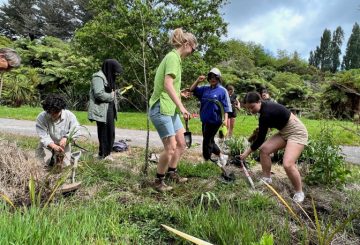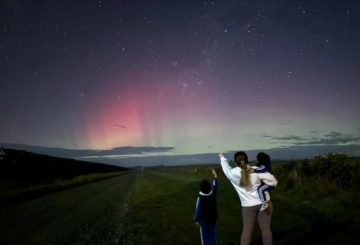Tối nay, những người theo dõi bầu trời ở Tauranga đang háo hức chờ đợi để xem liệu họ có thể ngắm nhìn ánh sáng phương Nam hay không, còn được gọi là Aurora Australis. Sự trưng bày ánh sáng tuyệt đẹp trên đường chân trời phía nam này là một cảnh tượng hiếm có ở khu vực này. Sự kiện này có thể thực hiện được bởi một nhóm lớn các vết đen mặt trời đang hoạt động gần đây đã giải phóng một số lần phóng khối lượng vành mạch (CME) về phía Trái đất.
Aurora Australis là một màn trình diễn ánh sáng tuyệt đẹp gây ra bởi các hạt tích điện từ mặt trời tương tác với từ trường và bầu khí quyển của Trái đất. Những hạt này, chủ yếu là electron và proton, va chạm với các khí trong bầu khí quyển của chúng ta, tạo ra màu xanh lá cây, hồng, tím và đỏ rực rỡ trên bầu trời đêm.
David Greig, chủ tịch Hiệp hội Thiên văn Tauranga, cho biết những CME này dự kiến sẽ đến vào cuối tuần, có thể tạo ra những màn hình cực quang tuyệt vời trên bầu trời phía nam. Anh ấy trấn an rằng không cần phải lo lắng, và đây là cơ hội tốt để có thể nhìn thấy Aurora Australis.
David giải thích rằng các vết đen mặt trời và hoạt động của mặt trời đạt đỉnh khoảng 11 năm một lần, và chúng ta hiện đang tiến đến đỉnh điểm. Những vết đen mặt trời này làm tăng gió mặt trời, dẫn đến cực quang tuyệt đẹp. Đỉnh cao cuối cùng xảy ra vào năm 2013, và đỉnh tiếp theo dự kiến trong khoảng thời gian từ 2023-2025.
Sự kiện này trùng với một thông báo “khẩn cấp lưới điện” do Transpower ban hành do một cơn bão không gian nghiêm trọng. Cơ quan này, cơ quan điều hành lưới điện của New Zealand, cảnh báo rằng một cơn bão địa từ có khả năng ảnh hưởng đến Trái đất vào cuối tuần này do hoạt động đáng kể của mặt trời.
David lưu ý rằng CME không thể đoán trước nhưng xảy ra thường xuyên hơn khi có nhiều hoặc nhiều vết đen mặt trời có thể nhìn thấy được. Ông nói thêm rằng hoạt động cực quang dường như có nhiều khả năng xảy ra xung quanh các điểm phân vào tháng 3 và tháng 9. Để nhìn thấy cực quang, bạn nên nhìn về phía nam từ một vị trí tối, tránh xa ánh sáng rực rỡ. Cực quang được nhìn thấy tốt nhất từ xa hơn về phía nam, nhưng trong quá trình hoạt động khắc nghiệt, nó có thể được nhìn thấy hoặc chụp ảnh từ xa hơn về phía bắc.
Nhiếp ảnh gia địa phương John van der Broek đã chụp được Ánh sáng phương Nam từ nhà của mình ở Maungatapu vào tháng 11 năm 2023 và có kế hoạch làm như vậy một lần nữa.
Solarham.com, một trang web cung cấp tin tức thời tiết không gian thời gian thực, đã báo cáo về cơn bão không gian mà nó đang theo dõi. Người phát ngôn của trang web cho biết, “Lần đầu tiên kể từ cơn bão Halloween năm 2003, ngưỡng Cơn bão địa từ cực đoan (G5) đã đạt được.”
David hiện đang theo dõi các dự đoán về thời điểm hoạt động cực quang dự kiến sẽ xảy ra. Ông khuyên bạn nên theo dõi các trang NZ Aurora Australis trên Facebook để biết thông tin cập nhật.
Với điều kiện ngắm cảnh lý tưởng được dự báo, đêm nay có thể mang đến một màn trình diễn ngoạn mục khi thiên nhiên sơn bầu trời với màu sắc rực rỡ.





























































